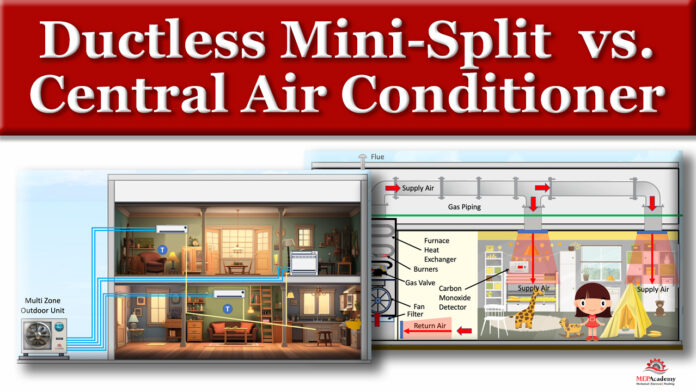Ductless vs. Central Air Conditioning: Which is Right for You?
Choosing the right air conditioning system for your home is a significant decision. Two popular options are ductless mini-split systems and central air conditioning systems. Each has its own set of advantages and disadvantages. In this article, we will compare these two cooling solutions to help you make an informed decision.
If you prefer to watch the video of this presentation than scroll to the bottom.
Ductless Mini-Split Systems
Ductless mini-split systems, also known as mini-splits or split-type air conditioners, are versatile and efficient cooling and heating solutions. Here are some of their key advantages and disadvantages:
Check out the latest cost of Ductless Systems.
Advantages of Ductless Mini-Split Systems:
1. Zoning Flexibility: Mini-splits allow you to create different temperature zones in your home, enabling personalized comfort and energy savings. You can cool or heat specific rooms as needed, as each room will have its own fan coil and controller. See our other video that shows you the differences between single and multi zone mini splits systems.
2. No Ductwork Required: As the name suggests, mini-splits don’t require ducts. This makes them an excellent choice for older homes or spaces without existing ductwork. Installation is typically less invasive and costly. Small copper tubing is easier to route through existing construction than larger air ducts. Refrigerant piping carries more cooling capacity per size than air ducts.
3. Energy Efficiency: Ductless systems are highly energy-efficient because they avoid the energy losses associated with ductwork. Ductwork creates resistance to airflow causes an increase in fan power. Compressor inverter technology allows for precise temperature control and reduces energy consumption by adjusting compressor motor speed.
4. Easy Installation: Professional installation of mini-splits is relatively straightforward and can often be completed in a day or less. See our video on Mini-Split Systems.
5. Quiet Operation: Indoor units of mini-splits are generally quieter than traditional central air systems, ensuring a peaceful indoor environment. There are multiple fan speeds allowing the user to lower the speed for quitter operation.
Disadvantages of Ductless Mini-Split Systems:
1. Upfront Cost: The initial cost of purchasing and installing ductless mini-splits can be higher compared to central air systems. The central system allows economy of scale by having fewer pieces of equipment to install and connect with utilities.
2. Aesthetics: While indoor units are compact and can be mounted on walls, some homeowners find their appearance less aesthetically pleasing compared to the discreet nature of central air vents.
Central Air Conditioning Systems
Central air conditioning systems are the traditional choice for many homes. Here are their key advantages and disadvantages:
Check out the latest cost of Central Air Conditioners.
Advantages of Central Air Conditioning Systems:
1. Whole-House Cooling: Central air systems can efficiently cool an entire house from a single thermostat. They are excellent for larger homes or multi-story buildings.
2. Uniform Temperature: Central air systems provide consistent temperature control throughout the house, eliminating hot or cold spots.
3. Aesthetic Appeal: Central air systems are hidden from view, with vents typically located on the ceiling or floor. This can enhance the overall aesthetics of your living space.
Disadvantages of Central Air Conditioning Systems:
1. Ductwork Required: Central air systems rely on ductwork for air distribution. Installation or retrofitting of ducts can be costly and invasive, especially in older homes.
2. Energy Loss: Ductwork can lead to energy losses due to leaks and poor insulation. This affects overall efficiency.
3. Limited Zoning: While some central systems offer zoning capabilities, they are less flexible compared to mini-splits in terms of creating customized temperature zones. Often central air conditioning systems serve the whole house without consideration for unoccupied spaces.
Conclusion
The choice between ductless mini-split systems and central air conditioning systems ultimately depends on your specific needs and preferences. If you prioritize energy efficiency, zoning flexibility, and don’t mind the upfront cost, ductless mini-splits may be the better choice. However, if you have a larger home and prefer a whole-house cooling approach with a discreet appearance, a central air system might be the way to go.
It’s advisable to consult with an HVAC professional who can assess your home and help you determine which system aligns best with your requirements and budget.






